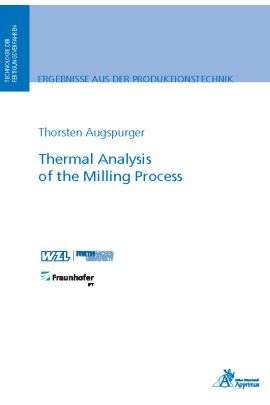The aim of the current work was the analysis of temperatures and heat flows in the milling process in order to understand causal and statistical relationships between process parameters and thermal state variables. These have a direct influence on tool wear in the process, dimensional accuracy and surface integrity.
The first step included fundamental empirical investigations in the form of orthogonal cuts to estimate the heat input into the tool, workpiece and chips depending on the machining work performed and the process parameters cutting speed and undeformed chip thickness. In principle, these heat inputs were determined by temperature measurements with thermography and pyrometry and the application of the first thermodynamic main theorem under simplified assumptions. In the orthogonal cuts the validity of the PÉCLET number could be shown as heuristics for estimating the heat flow distribution. The specific heat input per cutting length and depth as a function of cutting speed and undeformed chip thickness was finally approximated by a statistical model and transferred to the milling kinematics.
To measure the time-varying temperature fields in the tool and in the workpiece during milling, a synchronized measuring system and a test setup were designed, which ensures the necessary accessibility to the process. A second aim was to determine heat flows and their distribution during milling.
Based on the empirical data from the orthogonal cuts, stationary temperature fields in the workpiece were analytically modelled for milling using an existing variant of the JÄGER solution. The comparison between analytically simulated and measured temperature fields showed a qualitatively good agreement of the spatial properties.
Another goal of the work was the analysis of the transient volumetric temperature fields in the tool during the milling process and their modelling. To this end, the time-variant heat flow into the tool, modelled empirically and approximated by regression, was coupled with an analytical temperature model based on GREEN’S functions. The predicted temperature fields were compared with the measured time-varying fields on the tool lateral face. The temporal and local course of the temperature fields showed a good accordance of the short-term dynamics with respect to amplitudes and spatial distribution. The observations thus support the validity of the empirically modelled, specific heat flows into the tool.
| Autor | Augspurger, Thorsten |
|---|---|
| Lieferzeit | 3-4 Tage |
| Gewicht | 0.262 kg |
| Erscheinungsdatum | 21.12.2018 |
Technologie der Fertigungsverfahren
Thermal Analysis of the Milling Process
Kurzbeschreibung
The aim of the current work was the analysis of temperatures in the milling process in order to understand causal and statistical relationships between process parameters and thermal state variables. The first step included fundamental empirical investigations in the form of orthogonal cuts in order to estimate the heat partitioning depending on the process parameters. Based on the empirical data from the orthogonal cuts temperature fields in the milling process were modelled analytically and validated.

